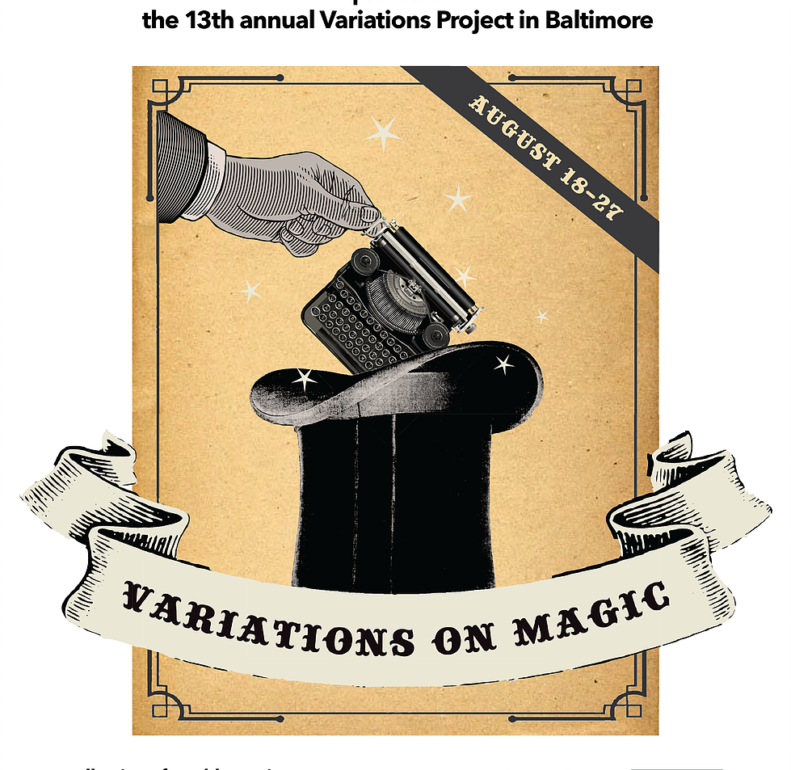Abracadabra! Presto! Poof! It’s that time of year for Rapid Lemon Productions to set up shop— this year just south of Station North at the Baltimore Theatre Project— with their annual variations project! Heading into its 13th year, this year’s project, Variations on Magic is directed by Lance Bankerd. Bringing just eight actors together to perform a dozen new ‘ten-minute’ plays, all submitted by local playwrights to the festival, Variations on Magic unearths the spectacle of magic, defining it, bending it, playing with it, in a series of unique and unusual plays, all threaded loosely together by the overarching theme. There’s even a bonus video-play, entered by Larry Malkus, playing in the lobby pre-show and featured in the theatre at intermission.
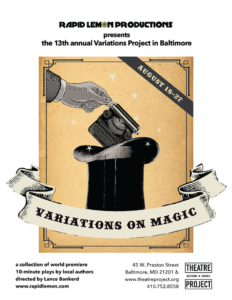
With one unified set, designed by Set Designer Bob Denton, the plays are able to move quickly one to the next, almost like the acts of a magic show. Interspersed between them is the clever soundscape crafted by Sound Designer Chris Allen. Denton’s set looks a little like the backstage area of a magic show held in a theatre, with posters of other magical acts— including a poster for Variations on Magic— plastered on the upright flats designed to emulate the wings. Allen’s sound design is well matched for both scenic transition from one show to the next as well as for the soundscapes developed within the plays. There is a lot of ‘canned laughter’ and ‘canned applause’ a la television sitcoms featured in at least two different shows, as well as more iconic magical effect stylized sounds, which threads the soundscape back to the overall theme of magic.
Though most of the sartorial selection featured in the plays are present day human articles, Costume Designer Deana Fisher Brill gets to go unleash her creativity for a handful of the plays, showcasing faerie wings, silver space suits, and iconic fairytale garb. The glamour gown used during An Incredible Magical Fairytale for the 21st Century is one of the most striking pieces in Brill’s collection, though the ensemble featured on The Old Witch in The Lies that I used to Do & The Theory of Motion is a very close second.

Director Lance Bankerd does an excellent job of casting each of the plays as well as fitting them into the set that Denton has designed. The props are minimal but not so barren as to over-engage the imagination. Bankerd’s approach to atmospheric effect keeps the air of mystery that everyone so dearly enjoys when it comes to magic and the unknown readily available with haze that floats precariously throughout the space over the course of the evening. Working closely with Lighting Designer Carly Shiner, the duo of creative minds bring multiple exciting effects into play, including a lot-plot built entirely around the use of total blackout and flashlights for the opening piece, This is How Ghosts Speak.”
This is How Ghosts Speak by Jen Diamond
Theatre33 is most definitely haunted— of course the very same could be said of any dark and spooky building when the lights go off inexplicably, plunging the inhabitants into total darkness. Playwright Jen Diamond very quickly establishes a sense of magical realism in the realm of her play; ghosts are real. In addition to creating a tight script with an readily moving pace to it, Diamond has constructed three characters that possess echoes of stock types— a hyper-animated janitor type, a deadpan Goth girl sort, and a spastically overworked and overwound manager— but manages to give them a fleshed-out depth in a surprisingly short stretched space. Diamond’s ability to make these characters exist realistically beyond their stock origins paired with her felicity for penning sensible dialogue that fits the characters she has created makes this piece an ideal show for opening the evening.
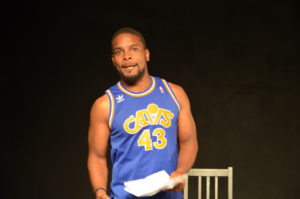
Mike Smith, Lee Conderacci, and Chara Bauer take on the characters of Walt, the excitable maintenance man, Jessie, the strung-out building manager, and Molly, the sardonic but hilarious magician, respectively. What makes this performance especially unique is that the entire show is performed in blackout, with two flashlights and the occasional glow of Jessie’s cell phone being the only light experienced. Conderacci and Smith’s exacerbating character personalities are the perfect balance for the calm and almost deathly still character that Bauer portrays. The whole dynamic between these three performers is a different type of magic all together, in addition to dealing with the magic of the otherworldly when it comes to being stuck in darkness in the basement of Theatre33.
An Island of Tears by Dovile Mark
Slightly less traditional than what might be expected, playwright Dovile Mark toys with the idea of folklore magic. Strongly asserting magical realism into her play, as the two talking character are Storks, she unfolds a creation myth style story that explains why the sea is salty around a particular island and why the storm becomes known as the bird that brings babies. Lance Bankerd takes a firm hold of the meta opportunity that Mark has written into the play and has a silent cast perform behind the two storks, re-enacting what the Old Stork (Martin Ealy) is telling the Young Stork (Chad Short) when it comes to the full story of the woman abandoned on the island and the grandfather stork.
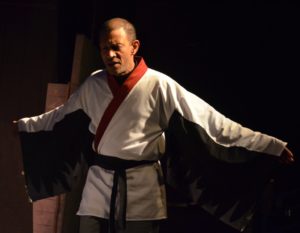
Chad Short does an exceptional job of embodying the eager questioning nature of the Young Stork character. With wide eyes and an indefatigable enthusiasm and thirst for knowledge, he all but emulates a cogent toddler with his persistent questioning. Martin Ealy does his best not to grow weary and exasperated by the perpetual questions, continuing on with the tale in hopes that the story will lull the younger bird to sleep.
Abracatinder by Andy De
Tinder! The magical dating app where all your wishes and dreams come true, right? Playwright Andy De has taken a hilarious and satirical poke at the app by making it the catalyst for the absurdly complex date that his two main characters— Jeremy (Chad Short) and Anna (Donna Ibale) find themselves experiencing. De’s writing is clever; the premise is unusual but really humorous. Buying immediately into the fact that Jeremy is a sorcerer— in a modern but non-Potter non-Tolkien fashion— makes watching him use various skills to set this disastrous dates to rights particularly funny. Augmented by Shiner and Allen’s sound and lighting effects every time the character has to invoke his sorcery, it’s one of the more humorous entries included in the production.

Short, who plays the man on the date, really grounds into the character and gets the swing of things going strong. Anyone who’s ever been on a Tinder date that’s started off with an awkward bang can relate to everything he’s putting into the character. Ibale, who plays the somewhat obnoxious Anna, balances out the other half of the date and heightens the humorous exchanges between the pair. Throw in Mike Smith as the hilariously out of place waiter, a cameo role that just augments the disastrous nature of the date, and you’ve got one of the best pieces submitted to this year’s Variations on Magic.
By Sarah, Age 24 by Alice Stanley
A one-woman piece is a risky move in a ten-minute play festival. But playwright Alice Stanley rises to the occasion even if the first few moments of the monologue piece take a little while to get going. This pacing issue aside, arising primarily from the overloading of throw-away dialogue laden onto the character in an attempt to establish nerves and awkwardness at the situation, Stanley’s work is emotionally blindsiding, addressing the broad issue of acceptance, using magic as a framing device for the core of her plot. The emotional depth that Stanley delivers in such a short timeframe is truly striking and by the end of the piece there a huge cathartic release to which so many individuals can readily relate. This is a hallmark of Stanley’s writing; the emotional turmoil that consumes the sole and ultimately finds its release at play’s end.
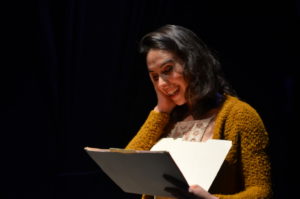
Taking the heavy task upon her shoulders, Chara Bauer is Sarah, the titular character. Although the early lines are a bit awkward, intentionally so in Stanley’s attempt to establish how out of character this situation is for Sarah, Bauer takes to them with aplomb, finding her footing and her pacing easily. As the magic, which is both contained in the emotional connection that the character has to the event happening and that Bauer has with the character, unfurls, so too do the tears. Bauer is gifted in the ability to perform while crying, doing so with an air of authenticity while still being articulate and understood. The piece is incredibly moving, and addresses acceptance of the individual on a surprisingly deep level, easily overcoming its rocky start.
Really? by Race Brown
Every play has one. One of these things is not like the others, and that would be Really? by Race Brown. The magical connection is difficult to find; the notion of magic in nearly any form seems to be hiding with its invisibility cloak unless there is some subtle notion that there is magic in the laughter created by viewing bad 80’s sitcoms. It’s an absurd two-minute piece that doesn’t last long enough for anyone to formulate an opinion on whether or not it really fits into the festival, let alone whether or not it has any merit. Nearly absurdist in its nature and outrageously over the top with characters, costumes, and melodramatic acting, Really? is a puzzlement.
To their credit, Mia Robinson, Lance Bankerd, Donna Ibale, and Martin Ealy, playing Candi, Ivan, Robin, and Carl respectively, all go to town with the melodramatic bad acting and make the show as humorous as possible to compensate for everything else.
In a Bottle by Justin Lawson Isett
What if a memory is so painful that you have to forget it? Playwright Justin Lawson Isett examines the magic of exactly that process in In a Bottle. Jennifer (Lee Conderacci) seeks out Bell (Mia Robinson) in order to forget. In a ritual that looks as if it might follow ancient magical practices— something along the lines of voodoo or summoning or another non-denominational witchcraft— Isett sets the characters down a path of discovery. There is a richness to his textual exchange between the two female characters, keeping Conderacci’s character teetering on the brink of desperation, driven there by grief. The only questionable moment of Isett’s work is the textual ending— Bankerd frames up a non-spoken interaction with Joni Mitchell’s “River” from Blue playing in the background to leave us all feeling slightly haunted— because it raises questions. If she’s come there to forget the thing she’s forgotten then how does she know what she’s come there to forget?
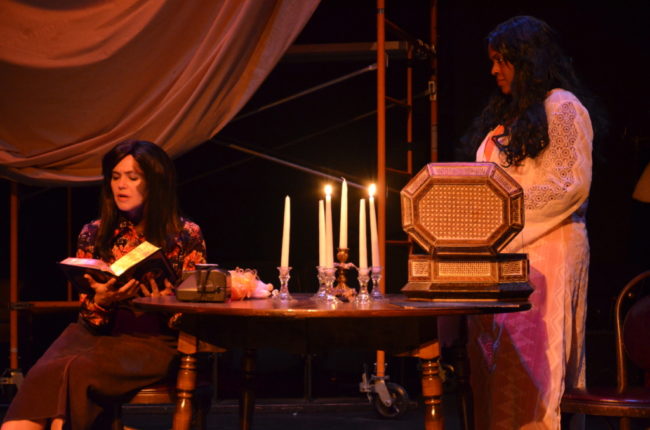
Conderacci and Robinson play well off one another, with Robinson existing as the calm and balancing force between the pair. At first Conderacci’s character starts off with a clipped demeanor, aloof and very businesslike. But as the reality of what she’s signing up for settles into plain existence, her mind shifts gears and the panic sets in. Robinson never once loses her composure, guiding Conderacci’s character through the ritual and evoking strong feelings with the memories they discuss. Ultimately a quaint piece that fits well within this year’s theme, In a Bottle is a firm way to end the first act of the evening.
Magic, Nebraska by Kevin Kostic
Cute, quaint, charming, and utterly magical, playwright Kevin Kostic explores the idea of the magic that can be found in rekindling the spark of a slowly-dying flame. Bankerd takes extreme creative license here and transforms the “Guides” into flossy, glossy faeries in purple, lime, and blue tutus with silly little wands. This enhances the magic of Magic, Nebraska, a town that is built and thrives upon the union of Sarah (Donna Ibale) and Lucas (Chad Short.) The narrative approach that Kostic takes is clean and simple; this allows the audience to free their mind and appreciate the romance that can flourish when two people really see each other for the first time, or again for the first time.
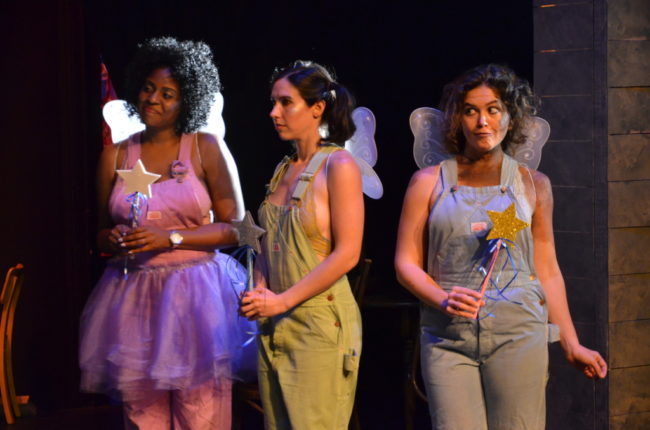
While Ibale and Short give lovely performances, the show stealers are Chara Bauer, Lee Conderacci, and Mia Robinson as the three ‘guides.’ Their whimsical behavior and affected vocalizations are precious and humorous, really creating a sense of mystery, wonder, and above all— magic— within the play. When they wave their wands, you get shooting stars and what could be more magical than shooting stars?
The Lies that I used to Do & The Theory of Motion by Tatiana Nya Ford
The most technically involved piece, as there is a whole illusion of a naked ballet happening in the background— featuring Donna Ibale and Chad Short— before the show even gets underway, there are sound and light cues galore in this space-themed out-of-this-world play. Playwright Tatiana Nya Ford overcomplicates the basic concept of a relationship gone bad and ending, and consequently destroying the universe, by layering deep space concepts, themes, and languages around it. If you can look beyond all of that and not get hung up or lost in it— as it a tall order to establish such a universe in such a short space of time— and see the simplicity that burbles in her plot, then there is something quite interesting and beautiful to behold.
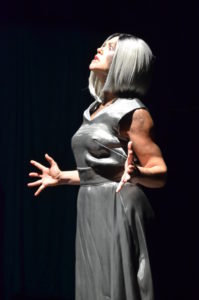
Lee Conderacci, playing The Old Witch, delivers some of the most emotionally harrowing text featured in the second half of Variations on Magic, while Martin Ealy serves as the Storyteller, delicately preaching words of caution and retelling what we witness Conderacci and Mike Smith, as The Commander, experience on stage in front of us. Despite the confusion, the actors are readily connected to the heavy gravitational pull of their emotions, fully away that their ended relationship has brought about the destruction of the universe as we know it.
An Incredible Magical Fairytale for the 21st Century by MJ Perrin
Chock full of fairytale references, exceptionally well penned, and brilliantly performed, MJ Perrin’s play is a proper contender for best in Variations on Magic. Taking an old trope— a wooden boy wishing to be real— and making it relevant to today’s acceptance issues, especially when it comes to the LGBT+ community, Perrin has done a remarkable job of handling a very serious topic in a heartfelt and humorous fashion. There is something convivial and delightful about the way the characters have been penned, even more so once you see them being performed. There is a truth and a lesson to be learned in Perrin’s work, but it isn’t heavily beaten over the audience’s head, rather shared in a sweet and tender fairytale fashion. Tragically, the ending reminds us that it is only a fairytale because rarely does acceptance happen with a snap and a wave of a magic wand.
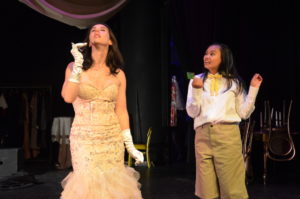
Lance Bankerd steps into the role of Gino in this production, the father of the wooden boy Angio (Donna Ibale.) His outrageous accent, hilarious physicality and vocal inflection when it comes to dealing with the whole situation is a hoot. Ibale holds her own against Bankerd— no easy task— and sticks to the physicality of the wooden puppet boy as a conduit for channeling her experience. Chara Bauer comes into the story at the midway point as Lily, the witch who will help the whole situation, and her witchy voice is perfect for inspiring a classic fairytale fear. The trio of performers delivers a great justice to Perrin’s work and the piece is extraordinary and magical all at once.
The Trial by Jeff Dunne
A witch hunt. Fear. Magic. Playwright Jeff Dunne ferociously tackles all of these things in The Trial. Set outside of time and place restrictions with this notion of timelessness about it, though clear hints and connotations that it belongs in the pre-colonial era, Dunne puts three council members on a proper witch hunt to condemn Mary (Mia Robinson) of witchcraft. The way Dunne manipulates words is sublime and the way he forces the elders to define magic is inspiring. What is magic? It is a question you’ll find yourself asking over and over as the play progresses. Having written a truly ferocious character in Mary, Dunne puts a lightning bolt of a play together in just ten short minutes and it’s brilliant.
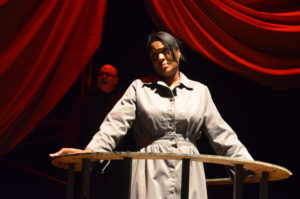
Robinson, as the fierce Mary, does not relent, particularly when it comes to accusing Charles (Martin Ealy), Colin (Chad Short), and Michael (Lance Bankerd). The trio of elders play a stereotypical role, barking their unfounded fears in true witch hunt fashion, until meticulously one by one Robinson’s character picks them apart, exposing their fears. The whole piece is thrilling and keeps you perched at the edge of your seat, cheering and hoping for the Mary character as she uses logic and reason to debunk their arguments one at a time. The Trial is readily a contender for best play in Variations on Magic this year.
Running Interference by Amy Bernstein
Cultural relevance and ignorance of a time forgotten allows playwright Amy Bernstein to get away with creating a prequel to the hit sitcom Bewitched. Though she hasn’t kept the meddling mother in-law character name, changing it to Calista (Mia Robinson) presumably for copyright dodging purposes, Bernstein has taken the idea behind the aforementioned show and flipped it around ever so slightly. It’s Marcus (Chad Short) with the enchanted sorceress mother and not Winnie (Chara Bauer) but the manipulative tactics that fall into place all come from the meddling mother-in-law. Sound master Allen even uses the sound effects from the show to leave no doubt in our mind that this is what Bernstein is going for.
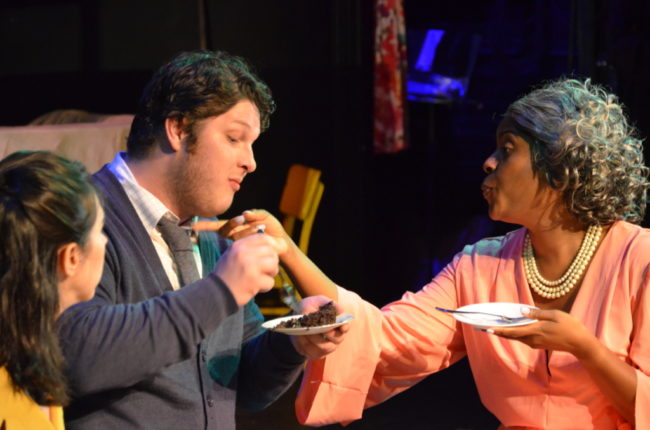
Bauer’s performance is hilarious as she shrieks and cries, constantly on edge as if he nerves might shatter like dropped porcelain. Chad Short gives her a run for her money with his oblivious performance in the role of Marcus, being completely suckered into the magic that Calista puts forth. Robinson, as the meddlesome mother-in-law, is cheeky and clearly displeased with the Winnie character, even giving a trademark style smirk at the end when saying she’s met this darling new girl Samantha that Marcus simply must meet.
The Miraculous Display of a Series of Feats of Spectacle by Utkarsh Rajawat
The other one-person show at Varations of Magic this year come from playwright Utkarsh Rajawat. Isn’t magic all about spectacle? Isn’t magic all about what is seen and what isn’t seen? Mike Smith, playing the Magician, spends the last few moments of the evening trying to impress the audience with his failed magic tricks and miserable attempt at spectacle. It’s written this way, clearly intentional, One of the more striking quotes contained within the piece, “…birth is an appearance, birth is pretty magical, so I don’t’ really see the point in trying to compete with birth…” does draw attention to the fact that magic is and can be anywhere and everywhere. Though the shenanigans that occur— with great enthusiasm and exhausting exertion on Mike Smith’s part— could be trimmed somewhat and still make the same point, it’s a curious and yet fitting way to conclude the evening’s events.
TADA
In conclusion there are several really great plays living a magical life upon the stage, with remarkable efforts from the performance and creative team. Each play only lasts in the upwards of 12 to 14 minutes with several of them falling in far shorter than that. Digest your magic in bite-sized plays, this is a great opportunity to experience Baltimore’s playwrights at their finest.
Running Time: Approximately 2 hours and 30 minutes with one intermission
Variations on Magic opens August 18, 2017 and plays through August 27, 2017 with Rapid Lemon Productions at Baltimore Theatre Project— 45 W. Preston Street in Baltimore, MD. For tickets call (410) 752-8558 or purchase them or purchase them online.
To examine playwright Jeff Dunne, click here.
To examine playwright Race Brown, click here.
To examine playwright MJ Perrin, click here.
To examine playwright Tatiana Nya Ford, click here.
To examine playwright Larry Malkus, click here.
To examine playwright Jen Diamond, click here.
To examine playwright Alice Stanley, click here.
To examine playwright Utkarsh Rajawat, click here.
To examine playwright Justin Lawson Isett, click here.

